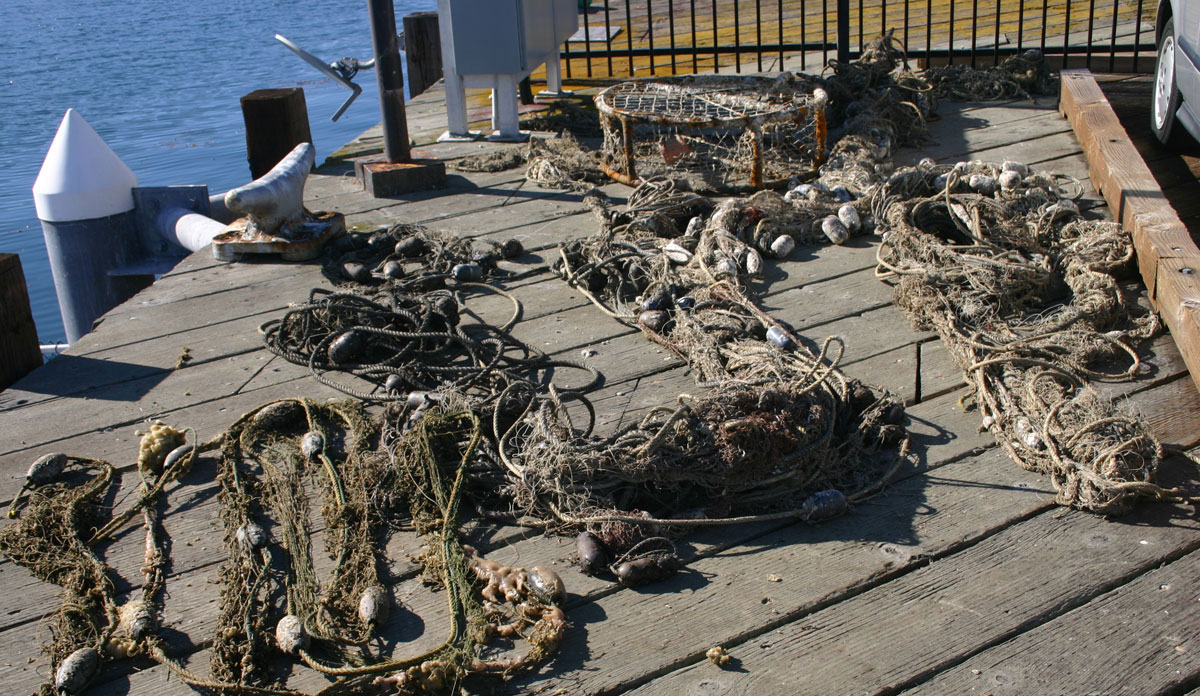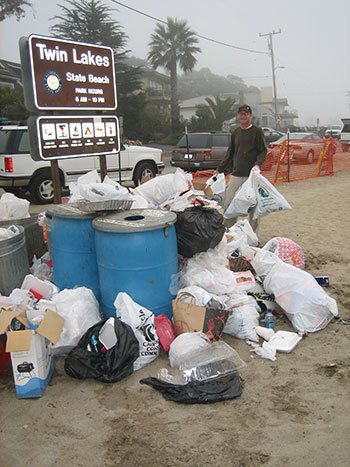Marine Debris
Monterey Bay

Why is it a concern?
Marine debris encompasses a wide range of materials and comes from many sources. Some debris, such as lost fishing nets, poses an entanglement risk to pelagic animals, especially large fishes, sea turtles, seabirds, and mammals. Lost fishing gear (e.g., crab cages) can create long-term entrapment mechanisms that continuously kill fauna for many years. Net materials are constructed to be strong and resilient, thus preventing escape of entangled wildlife and persisting in the environment for decades. Mobile nets and traps can physically scrape organisms off of hard reef habitat or sweep immobile invertebrates from sandy areas.
Monitoring of hauled-out seals and sea lions on Southeast Farallon Island during the period 1976-1998 documented a total of 914 individuals that were entangled in synthetic material. Of a total of 6,196 live stranded seals and sea lions admitted to a rehabilitation center on the central California coast from January 1986 to September 1998, 107 (1.7%) had lesions caused by entanglement with manmade marine debris, including active or discarded fishing nets and monofilament line, packing straps, plastic bags, rope, and rubber o-rings.
Marine animals and seabirds in the sanctuary can also be harmed by ingesting marine debris, often mistaking it for food resulting in starvation or poisoning. Plastics in the marine environment never fully degrade and recent studies show plastic is consumed by organisms at all levels of the marine food web. The sanctuary’s Beach COMBERS monitoring program has collected carcasses of dead seabirds for study by local researchers. Analysis of the stomach contents of 190 Northern Fulmars collected along Monterey Bay beaches in 2003-2004 found that 71% of the birds had plastic in their stomachs. In similar studies, plastic was observed in the stomachs of 67% of the 27 Red Phalaropes collected in 2005-2006 and 56% of the 16 Horned Puffins collected in 2007. These species of seabirds, and other seabirds such as albatrosses and shearwaters, are migratory birds that depend on the highly productive waters of Monterey Bay to feed. These seabirds are susceptible to plastic ingestion everywhere they feed, including the sanctuary.
Overview of Research
| Project Name | PI and contacts | Links |
|---|---|---|
Beach COMBERS |
Moss Landing Marine Laboratories, Monterey Bay National Marine Sanctuary, California Department of Fish and Game, Marine Wildlife Veterinary Care and Research Center |
http://montereybay.noaa.gov/research/bchmon.html http://www.sanctuarysimon.org/monterey/sections/beachCombers/index.php?l=n |

Science Needs and Questions
- What are the types and accumulation rates of probable Japan Tsunami Marine Debris (JTMD) within MBNMS?
- What tools are available to detect JTMD before they enter MBNMS?
- What groups outside of NOAA are receiving and inventorying reports of JTMD?
- Are certain areas more or less susceptible to JTMD accumulation and/or impacts?
- Are there critical habitat areas that should be prioritized for JTMD or other debris removal efforts?
- Are certain types of debris more likely to contain contaminants and can those be targeted for removal?
- Are certain categories of debris more likely to transport invasive species?
- What are the biological and cultural impacts to marine and coastal resources of JTMD removal efforts?
- What are the biological and cultural impacts of disregarding JTMD and other marine debris?
Education and Outreach Material
NOAA Marine Debris Program Education Materials
References
CIWMB (California Integrated Waste Management Board). 2004. Use and Disposal of Polystyrene. In: California: A Report to the California Legislature. Integrated Waste Management Board, Sacramento, CA.
Gittings, S.R., M. Tartt, and K. Broughton. 2013. National Marine Sanctuary System Condition Report 2013. U.S. Department of Commerce, National Oceanic and Atmospheric Administration, Office of National Marine Sanctuaries, Silver Spring, MD. 33 pp.
Goldstein, T., S.P. Johnson, A.V. Phillips, K.D. Hanni, D. A. Fauquier, F.M.D. Gulland. 1999. Human-related injuries observed in live stranded pinnipeds along the central California coast 1986-1998. Aquatic Mammals 25:43-51.
Hanni, K. D. and P. Pyle. 2000. Entanglement of pinnipeds in synthetic materials at South-east Farallon Island, California, 1976-1998. Marine Pollution Bulletin 40:1076-1081.
Nevins, H., D. Hyrenbach, C. Keiper, J. Stock, M. Hester, J. Harvey. 2005. Seabirds as indicators of plastic pollution in the North Pacific. Paper for Plastic Debris Rivers to the Sea Conference 2005.
NOAA (National Oceanic and Atmospheric Administration). 2008. Marine Debris Emergency Response Planning in the North-Central Gulf of Mexico Interim Draft Report. 44pp.
Office of National Marine Sanctuaries. 2015. Monterey Bay National Marine Sanctuary Condition Report Partial Update: A New Assessment of the State of Sanctuary Resources 2015. U.S. Department of Commerce, National Oceanic and Atmospheric Administration, Office of National Marine Sanctuaries, Silver Spring, MD. 133pp.
Phillips, E., H. Nevins, C. Gibble, J. Harvey, D. Jessup. 2007. Puffin invasion 2007: summary of Horned Puffin (Fratercula corniculata) mortality event based on gross examination. Report to California Department of Fish and Game, Sacramento, CA.
U.S. Dept. of Commerce and U. S. Navy. 1999. Turning to the Sea: America’s Ocean Future. 56 pp.
Watters, D., M. Yoklavich, M. Love. 2008. Marine debris in deepwater benthic habitats off California: is there a problem? Poster at: Monterey Bay National Marine Sanctuary Currents Symposium, April 5, Monterey, California.
Zabka, T., H. Nevins, E. Phillips. 2006. Summary of Red Phalarope (Phalaropus fulicaria) wreck based on gross examination. Report to California Department of Fish and Game, Sacramento, CA.

